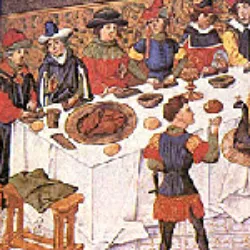Curiosities and Challenges about Portugal
Do you like Portugal?
Would you like to see more curiosities like these..
The Portuguese colonization of Brazil from 1530 onwards brought a diversity of foods and spices, a result of relations....
In the city of Barcelos, Portugal, there was concern due to an unsolved crime. A Galician suspect, who was passing..
Local legend says that D. Garcia, the mayor of Penha Garcia Castle, had courted D. Branca, daughter of the governor of....
So.. How about a Challenge on the Best Quiz Platform in the World?
May your journey be full of discoveries
Get to know a little about everything and bet on your knowledge in incredible challenges and duels..
Join the betspot.zone community, accumulate bts (bets) and even compete for prizes..
Discover some interesting facts about Portugal..
tourism Quiz - tourism Curiosities - tourism Challenge - culture Quiz - culture Curiosities - culture Challenge - portugal Quiz - portugal Curiosities - portugal Challenge - folklore Quiz - folklore Curiosities - folklore Challenge - - Frequently asked questions about Portugal
The Revolution of April 25

The Revolution of April 25 , also known as the Carnation Revolution, was a historic event in Portugal, which took place on April 25, 1974, which overthrew the dictatorial regime of the Estado Novo, in force since 1933. Led by the Armed Forces Movement (MFA ), composed mainly of captains who had participated in the Colonial War, the movement enjoyed massive popular support. The military action resulted in few civilian casualties and led to the appointment of the National Salvation Board to govern the country. There followed a period of social and political unrest known as PREC (Revolutionary Process in Progress). On April 25, 1976, a new democratic Constitution came into force, marking the end of the authoritarian regime and the beginning of a democratic period in Portugal. The military coup was triggered by dissatisfaction with the colonial war, internal divisions within the regime and political repression.
celebrate in April 25
publicity
Saint Mafalda

Saint Mafalda 's Day, celebrated on May 2 , honors the life and virtues of the Portuguese infanta, known for her beauty and grace. She became queen of Castile at the age of 12, after marrying King Henry I, but the marriage was dissolved within just a year. Instead of seeking his inheritance after his father's death, he chose to distribute his assets among the poor and monasteries, dedicating himself to religious life and serving those in need. After her death on May 1, 1256, she was canonized by the Catholic Church in 1973. Her incorrupt body, discovered during exhumation for transfer, became the object of great religious devotion. The day is an opportunity for the Portuguese to reflect on their values and contributions to society.
celebrate in May 2
The Apostle of Faith and Divine Revelation

Saint Philip , celebrated on May 3 , was one of the first followers of Jesus, born in Bethsaida, Galilee, and was previously a disciple of Saint John the Baptist. Although mentioned little in the Gospels, he played an important role among the disciples. He presented the discovery of Jesus as the Messiah to Nathanael and had a notable participation in the multiplication of the loaves. At the Last Supper, his question about seeing the Father resulted in a profound revelation of Jesus' divinity. After the resurrection of Jesus, Philip dedicated himself to preaching the Gospel in Greece and Phrygia, accompanied by his family. Accounts of his death vary, with some indicating that he was crucified upside down and others that he was stoned. His devotion and sacrifice exemplify his dedication to the Christian faith.
celebrate in May 3
Saint Florian

Saint Florian 's Day, celebrated on May 4 , honors a 3rd-century Christian Roman official born in Germany. He governed the Roman province of Norica, today Austria, and stood out for training soldiers to fight fires, being recognized as the patron saint of firefighters. According to legend, during a serious fire, he said a prayer and used a bucket of water to extinguish the flames, impressing many and converting some to Christianity. However, his faith brought him into conflict with Roman authorities during the persecution of Christians under Emperor Diocletian. Florian refused to renounce his faith and was martyred, tied to a millstone and thrown into the River Enns, where he drowned. His celebration is marked by special ceremonies and tributes to firefighters around the world.
celebrate in May 4
publicity
Saint Elizabeth of Portugal

Saint Elizabeth of Portugal 's Day is celebrated on July 4th . Saint Elizabeth, also known as Elizabeth of Aragon, was a queen known for her charity and generosity towards those less fortunate. She was born in 1271 and died in 1336. Saint Elizabeth is remembered for her charitable works, including creating hospitals and distributing food to the poor. She is also known for her deep commitment to the Christian faith and her prayer life. Her devotion to helping those in need made her a revered and respected figure in Portugal and beyond.
celebrate in July 4
National Castle

National Castle Day is celebrated on October 7th in Portugal . This date was created to promote the appreciation and preservation of the historical and cultural heritage represented by the country's castles. Castles, which date back to different periods in Portuguese history, are important architectural and tourist landmarks, as well as symbols of national identity. During this day, several activities are held in many castles, such as guided tours, historical reenactments, workshops and exhibitions, allowing the public to learn more about the history and importance of these monuments.
celebrate in October 7
Magusto is a festival between October and November

Magusto is a festival between October and November, associated with dates such as Saint Simon's Day, All Saints' Day and Saint Martin's Day. It is celebrated around bonfires, roasting chestnuts with jeropiga, açaí or new wine. The brave jump over the bonfire, and "filling" it with ashes is part of the tradition. Despite the rain in autumn, "Saint Martin's summer" brings sunshine. The legend of Saint Martin, related to a rainy day, explains this phenomenon. A specific tradition, the "Magusto da Velha", takes place in Aldeia de Viçosa on December 26, honoring a rich old woman with the throwing of chestnuts from the bell tower and prayers. The event in Barqueiros, Mesão Frio, connects magusto to ancient rituals in honor of the dead.
publicity
A Monastic Secret that Enchanted the World

The history of Pastel de Belém dates back to the beginning of the 19th century and is linked to the monks of the Jerônimos Monastery, in Belém, Lisbon. They would have created the sweet to use surplus gems from the hosts. The monks kept the secret of the recipe, but after liberal revolutions in 1920, they had to leave the monastery. A sugar merchant, Domingos Rafael Alves, discovered the secret and began selling the sweets as "Pastéis de Belém". The region attracted tourists, strengthening the sweet's fame. In the 20th century, Pastel de Belém became a tourist and gastronomic icon in Portugal, with visitors from all over the world trying this delicacy. The local proverb says: "a bride who eats pastry never takes off her ring", and it is common to see newlywed couples enjoying this sweet treat on their wedding day as part of the tradition.
Duck rice is a dish of Portuguese origin that

Duck rice is a dish of Portuguese origin that is believed to have been created at the Braga seminary. This city was founded by the Romans around 16 BC. A city renowned for its culinary skill. The traditional recipe was made with wild ducks. There are those who say that it emerged as an alternative to reusing useless food. It became famous because duck meat is known for its soft texture and strong flavor. The dish is rich in proteins and nutrients that are beneficial for the skin and healing. Duck meat can be high in calories due to its skin, but when removed it becomes a light option. Additionally, duck rice provides an amino acid called glycine, which is essential for bone health and brain function.
Serra da Estrela PDO Cheese

Serra da Estrela PDO Cheese is the oldest cheese in Portugal, originating in the Serra da Estrela region. This cheese is made with raw milk from sheep of the Bordaleira da Serra da Estrela or Churra Mondegueira breeds. It is known for its creamy texture and buttery spread. There are two varieties: one with a semi-soft texture and yellowish white color (Queijo Serra da Estrela) and the other with a semi-hard to extra-hard texture and a brownish-orange color (Queijo Serra da Estrela Velho). Its history dates back to Roman times and was mentioned in the works of poet Gil Vicente in the Middle Ages. In 1287, King Dom Diniz established the first cheese factory in Celorico da Beira, in the Serra da Estrela region, becoming a nutritious and lasting food source for explorers. In 1885, the cheese arrived in Lisbon and Porto, increasing its popularity.
publicity
The Wealth of Regional Flavors and Traditions

Portuguese stew is a traditional Portuguese dish, with regional variations. The basic recipe includes beef, pork and chicken, beef and blood chorizo, farinheira and black pudding, Portuguese cabbage and savoy cabbage, carrots, potatoes and turnips. Regional variations may include ingredients such as fatty chicken, ham, salpicão, pork snout, alheira, rice, corn, pig ear, beef chorizo, blood chorizo, sausage, lamb, green beans, sweet potato, mint, yam and smoked bacon, depending on the region of Portugal where the dish is prepared.
Francesinha is a delicacy originating from Porto, Portugal

Francesinha is a delicacy originating from Porto, Portugal, made with two slices of lightly toasted bread, filled with beef steak, sausage, mortadella, fresh sausage and cheese. The sandwich is covered with several slices of cheese and placed in the oven until melted. The most important ingredient is the hot and spicy sauce. The story goes that it was created in the fifties, by a Portuguese named Daniel David Silva, who, having been an emigrant in France, used as inspiration one of the most typical sandwiches in France, the “Croque-Monsieur”, but adapted to the taste and gastronomic culture of the city of Porto. The quality of the meat and bread, as well as the diversity of alcoholic beverages in the sauce, influence the flavor of Francesinha, making it a beloved delicacy in the region.
Alheira is a traditional sausage in Portuguese cuisine

Alheira is a traditional sausage in Portuguese cuisine, with a famous version in Mirandela. It is a horseshoe-shaped smoked sausage filled with meat of different species, bread and seasonings. Supposedly, it was created by Jews in the 15th century in Portugal to disguise the consumption of pork, prohibited in the Jewish religion, in order to avoid persecution by the Inquisition. The recipe also ended up being appreciated by Christians, who added pork. Alheira is often grilled or roasted, served with side dishes such as potatoes, vegetables or rice, and is even enjoyed as an appetizer in some places, served with bread.
publicity
The Vikings were the pioneers in discovering cod

The Vikings were the pioneers in discovering cod, drying it in the open air for preservation. In the mid-14th century, Portugal began to link fishing and salting. During the Discoveries in the 15th century, the Portuguese discovered that cod was the perfect food for long sea voyages and began fishing for it in the waters of the northern Atlantic. Cod is traditionally dried and salted, preserving its nutritional properties. Portugal has a quality cod processing industry and exports to countries such as Brazil, France, Angola and Italy. Cod is a rich source of proteins, minerals and omega-3 fatty acids, and is considered a healthy food. It can be prepared in different ways, such as: Gomes de Sá style, Brás style, with cream, roasted with potatoes, etc.
The Portuguese Delight of Popular Festivals

Roasted sardines are a traditional dish in Portugal, especially during the festivals of popular saints. Originally from Sardinia, these sardines were essential for feeding rural families. Normally, they are seasoned with coarse salt, placing them on a double grill over the coals, without flame, roasting over low heat, normally accompanied by roasted peppers and boiled potatoes. They should be enjoyed by placing them on top of a thick slice of bread, allowing the bread to absorb the flavor and natural fat of the sardines.
The marafona, also called matrafona in Alentejo

The marafona, also called matrafona in Alentejo, is a rag doll dressed in colorful regional costumes. These dolls play a significant role in local celebrations, such as the Festa das Cruzes in Monsanto, where single women dance with the marafonas. After the party, the dolls are placed on the beds to protect the house from storms and the evil eye. At weddings, they are kept under the bed to bring fertility and happiness to the couple. Marafonas are also an important part of the Caretos de Podence festival, in which a marafona is a masked woman. There is a legend that these dolls were used to trick the Moors during a siege at Monsanto. They also parade at the Torres Vedras Carnival.
publicity
Manuel, a brave soldier from Belmonte

Manuel, a brave soldier from Belmonte, was captured by the Muslims and became a slave in Algiers. Despite the years of captivity, Manuel never lost hope of returning to his homeland and seeing the Virgin of Hope. When he explained its meaning to a Moor, his work became more arduous. However, the Virgin of Hope intervened, causing the ark where Manuel slept to take flight and disappear towards the sea, leaving all the Moors astonished.
At the end of the 15th century

At the end of the 15th century, about 1 kilometer above the current church of Nossa Senhora do Monte, a girl played with a shepherdess, who offered her food. The shepherd girl's story was not believed, so her father spied the scene and saw an image of the Holy Mary in the girl's company. The local authority placed the image in the Capela da Incarnação, close to the church of Nossa Senhora do Monte, giving the image that name. Another version of the legend tells of a stream of water that was diverted by a wealthy man, depriving the community of access to water. In desperation, the people made a procession to Senhora do Monte, and the water began to flow again, benefiting everyone. This event became known as the miracle of Senhora do Monte in Madeiran popular memory.
Many years ago on the island of Terceira, in the Azores

Many years ago on the island of Terceira, in the Azores, a young noblewoman was forced to marry a man her father had chosen. However, her heart belonged to a house slave. Despite the conventions of the time prohibiting such love, the two secretly fell in love. When the husband found out, he had the slave arrested. He fled through the hills, but when he found himself cornered, his tears of sadness gave rise to a lake. Pursued by hunting horses, the slave jumped into the lake and drowned. The lagoon became known as the "Lagoa do Negro" and is located on the island of Terceira, in the Azores.
publicity
In this Cascais legend

In this Cascais legend, there was a castle inhabited by a malevolent sorcerer (or giant). The sorcerer chose the most beautiful maiden in the region to marry, but when he saw her in person and was rejected, he locked her in a tower near the sea. He hired a knight to guard it. Years passed, and the knight and the maiden fell in love, deciding to run away together. The sorcerer, furious, summoned a storm that opened rocks on the coast, swallowing the lovers into the sea. The resulting hole became known as the "Boca do Inferno" due to the tragedy. On stormy days, they say the place seems to mourn the lovers' unhappy story.
Local legend says that D

Local legend says that D. Garcia, the mayor of Penha Garcia Castle, had courted D. Branca, daughter of the governor of Monsanto. On a stormy night, D. Garcia kidnapped her from her father's house. The governor ordered his soldiers to look for D. Garcia and bring justice. After months of pursuit, D. Garcia was finally captured on the slopes of the mountain. Despite the death penalty common at the time for such crimes, the governor, responding to his daughter's pleas, spared D. Garcia's life, but ordered the amputation of his left arm as punishment. Legend has it that the ghost of D. Garcia, the severed one, is seen on stormy nights, watching over Monsanto hill from the towers of Penha Garcia.
In the city of Barcelos, Portugal

In the city of Barcelos, Portugal, there was concern due to an unsolved crime. A Galician suspect, who was passing through on a pilgrimage to Santiago de Compostela, was arrested and sentenced to death on the gallows. He swore his innocence and asked to be taken to the judge who sentenced him. The desperate Galician said that his innocence was as certain as the rooster on the judge's table would crow when he was hanged. Everyone laughed at the statement, but no one touched the rooster. Surprisingly, when the Galician was about to be hanged, the rooster on the table crowed. The judge rushed to the gallows and discovered that the Galician was alive due to a poorly tied knot in the rope. He was released, and the case was closed. Years later, the Galician returned to Barcelos and sculpted the Monument of Senhor do Galo in honor of the Virgin Mary and Santiago Maior. The Rooster of Barcelos has become a popular symbol, representing justice and innocence in Portugal.
publicity
The Portuguese colonization of Brazil from 1530 onwards brou

The Portuguese colonization of Brazil from 1530 onwards brought a diversity of foods and spices, a result of relations between Portugal and India. With the court moving to São Vicente (today São Paulo), foods such as rice, coriander, mint, oranges and spices were introduced. Livestock activity began with the introduction of various animals. Rice cultivation resulted in dishes based on this ingredient, and the use of spices such as salt, rosemary, cinnamon and cloves became common. Notable influences on Portuguese cuisine include Brazilian feijoada and desserts such as marmalade, orangeade, rice pudding and sponge cake.
Back
